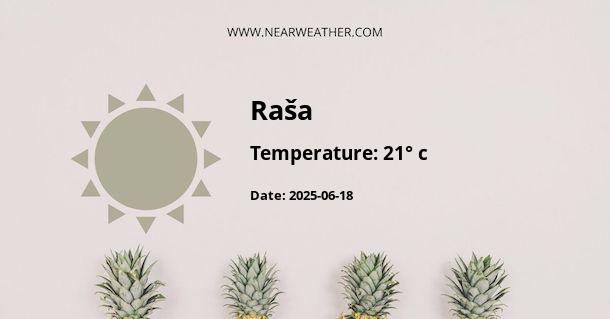Understanding the Climate and Weather of Rasa, Croatia
Located in the Istrian peninsula of Croatia, the picturesque town of Rasa boasts a climate that is characteristic of the region's Mediterranean allure. This unique climate and weather pattern of Rasa contribute to its charm as a destination year-round, attracting visitors with its moderate temperatures, plentiful sunshine, and a temperate Adriatic influence. In this analysis, we will explore the climatic features, delve into the monthly weather variations, and discuss what these conditions mean for locals and tourists alike.
The Climate of Rasa: A Mediterranean Overview
The Mediterranean climate is typically categorized by mild, wet winters and hot, dry summers. Rasa's location near the Adriatic Sea plays a pivotal role in moderating temperatures, ensuring that extreme weather is uncommon. The moderating influence of the sea leads to a narrow annual temperature range, favorable for outdoor activities and agriculture, such as olive growing and viticulture, which are vital to the region's economy and culture.
Seasonal Weather Patterns in Rasa
The weather patterns that define Rasa's distinct seasons are influenced by various atmospheric conditions, including the prevailing winds and sea currents. Let's dissect these patterns season by season for a comprehensive understanding.
Spring in Rasa
Spring in Rasa begins with a gradual warming trend. As the Adriatic begins to heat up, the cool and occasionally rainy days of early spring give way to more temperate conditions.
March typically heralds the start of this transitional season, with average highs of 13°C (55°F) and lows of 7°C (45°F). By the time May concludes, the daily highs often reach a comfortable 21°C (70°F).
| Month | Highs (°C) | Lows (°C) | Precipitation (mm) |
|---|---|---|---|
| March | 13 | 7 | 64 |
| April | 17 | 11 | 77 |
| May | 21 | 15 | 57 |
Summer in Rasa
Summers are warm and generally dry, with the "Maestral" - a cooling northwestern wind - providing relief from the heat. June through August are peak tourist months, when beachgoers and cultural enthusiasts flock to the region.
July is the warmest month, with daytime averages reaching 28°C (82°F) and seldom dipping below a balmy 20°C (68°F) at night.
| Month | Highs (°C) | Lows (°C) | Precipitation (mm) |
|---|---|---|---|
| June | 25 | 17 | 56 |
| July | 28 | 20 | 40 |
| August | 28 | 20 | 85 |
Autumn in Rasa
As summer wanes, autumn months bring cooler temperatures and an increase in rainfall. This is the season when the "Bura", a dry and cold northeasterly wind, can cause sudden weather changes.
September still enjoys warmth, with highs around 24°C (75°F), but by November, the highs drop to a cooler 15°C (59°F).
| Month | Highs (°C) | Lows (°C) | Precipitation (mm) |
|---|---|---|---|
| September | 24 | 17 | 85 |
| October | 20 | 13 | 99 |
| November | 15 | 9 | 110 |
Winter in Rasa
The winters are generally mild compared to more continental regions of Europe. The Adriatic Sea has a thermal inertia which prevents temperatures from plummeting.
December and January are the coldest months, with average lows of 6°C (43°F). Snowfall is rare, and if it does occur, it hardly ever lasts more than a few days.
| Month | Highs (°C) | Lows (°C) | Precipitation (mm) |
|---|---|---|---|
| December | 11 | 6 | 112 |
| January | 10 | 6 | 78 |
| February | 11 | 6 | 75 |
Extremes and Unusual Weather Events
Although Rasa enjoys a generally stable climate, it is not immune to extreme weather events. The Mediterranean basin can occasionally experience extreme weather events such as "Medicanes" (Mediterranean hurricanes), though these are rare and seldom affect the Istrian peninsula directly. Additionally, summer scorchers can lead to heightened risks of wildfires in the surrounding natural landscapes
What This Means for Rasa
Understanding the climate and weather year-round in Rasa is essential for its agricultural practices, tourism, and local lifestyle. Vineyards, olive groves, and truffle-rich forests thrive here. Tourism is significantly impacted by the predictably pleasant summer weather, though spring and autumn also present excellent opportunities for outdoor activities with fewer crowds.
Given its maritime influences, the Istrian coast, including Rasa, is experiencing the impacts of climate change, with rising sea levels and warmer overall temperatures.
The insights into Rasa's weather patterns enable business owners, farmers, and urban planners to make informed decisions about crop cultivation timing, tourism management, and infrastructure development. For tourists considering a visit to Rasa, this information is key to determining the ideal travel window to experience the town's natural beauty and cultural offerings at their best.
Conclusion
The climate and weather of Rasa, Croatia, are characterized by a favorable Mediterranean climate with distinct seasonal shifts and an overarching temperate nature. This contributes to the area's thriving tourism industry and agricultural economy, and knowing what to expect weather-wise when planning a trip or activity in Rasa is invaluable.
Climatic data indicates a region graced with plenty of sunshine, moderate rainfall, and the cleansing winds - all factors which have shaped the natural beauty and lifestyle of the region. These patterns are reflective of Rasa's geographic luck, nestled on the fertile and scenic shores of the Adriatic Sea.
In preparing for the future, Rasa and its inhabitants are attuned to the larger context of climate variability and change, enabling them to sustainably leverage their climate for continued prosperity. For visitors, Rasa offers a promise of memorable experiences under a friendly Croatian sky, regardless of the season.
A - Raša's Latitude is 45.080280 & Longitude is 14.078890.
A - Weather in Raša is 8° today.
A - Climate Conditions in Raša shows overcast clouds today.
A - Humidity in Raša is 57% today.
A - Wind speed in Raša is 26.89 km/h, flowing at 41° wind direction. today.
